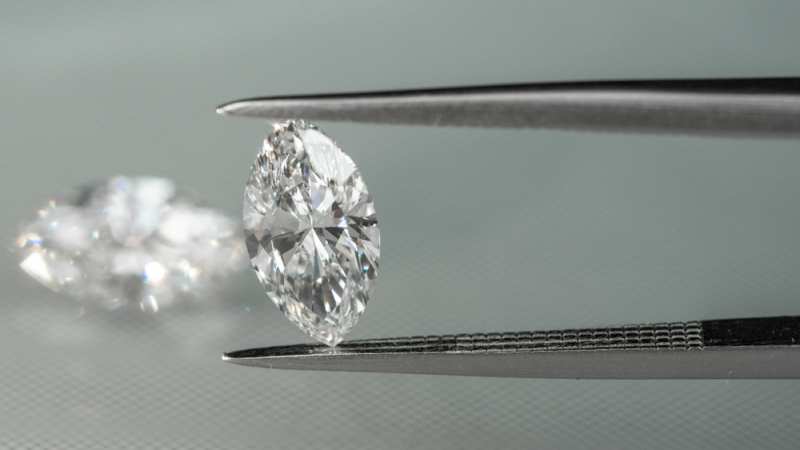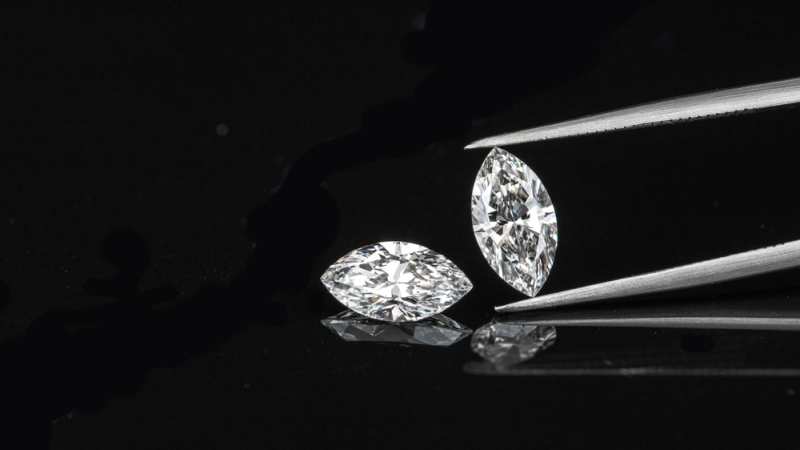Are you familiar with the exquisite marquise diamond, a true gem fit for royalty?
When it comes to selecting the perfect engagement ring, a marquise diamond offers a unique and distinctive option. Unlike the traditional round diamond, this captivating diamond cut introduces an elegant blend of edges and asymmetry to your ring design, creating a truly remarkable piece.
Not only is the marquise diamond a stunning choice, but it also carries a sense of history and antiquity, adding to its allure and charm.
Before investing in any diamond, it is crucial to carefully evaluate its price, quality, and overall appeal. Many individuals rely on the “4 Cs” – cut, color, clarity, and carat weight – to assess a diamond’s quality.
However, navigating through the myriad of factors to find a diamond that aligns with your personal taste and style can be a daunting task. In this article, we aim to guide you through the essential considerations involved in selecting the perfect diamond, while also delving into the distinctive characteristics of marquise diamonds.
DESIGN YOUR OWN ENGAGEMENT RING: START WITH A SETTING OR START WITH A DIAMOND. IT’S REALLY UP TO YOU!

What Are Marquise Diamonds?
The marquise diamond, characterized by its football-shaped cut, is crafted in a refined brilliant-cut style. With 56 facets and an elongated elliptical shape featuring pointed ends, this diamond cut offers a distinctive aesthetic.
One of the notable advantages of the marquise diamond’s elongated design is its ability to create the illusion of slimmer and longer fingers when worn as a ring. Additionally, this elongation enhances the diamond’s visual impact, making it appear larger than its actual carat weight.
Opting for a marquise cut for an engagement ring can be a smart choice as it allows you to save money while maximizing the value of the center diamond. The diamond can be set vertically (north-south) like a tower or horizontally (east-west) for a more contemporary and edgy look, offering two distinct orientations to choose from.
Overall, the marquise diamond stands out as an exceptional choice for those seeking a unique and striking gem. Its history dates back to the 18th century when King Louis XV of France commissioned a jeweler to create a cut resembling the lips of his lover, Jean Antoinette Poisson, Marchioness Madame de Pompadour. Legend has it that this request stemmed from the King’s admiration for her lips, leading to the creation of the marquise cut.
The term “marquise” refers to a hereditary rank higher than a count but lower than a duke, and courtiers used to adorn themselves with marquise-cut stones to display their status. The marquise diamond is also referred to as “navette” due to its boat-like shape. While initially designed for diamonds, this cut is now widely employed with other gemstones such as emeralds, rubies, and sapphires.

How To Choose A Marquise Diamond
Now that you have an understanding of what a marquise diamond is, let’s delve into what to consider when purchasing one.
To begin, let’s explore the 4Cs of marquise-cut diamonds, followed by other essential factors to keep in mind when selecting this diamond shape.
Anatomy of a Marquise Diamond
The marquise diamond is a type of “fancy shape,” meaning it deviates from the traditional round shape. To choose a beautiful marquise diamond, it’s important to familiarize yourself with its components.
The belly is the central area where the sides curve out the most, and it is crucial because it determines the width of the diamond.
The point is formed by the intersection of the two curved sides at each end.
The curved section between the belly and the point is known as the wing.
The girdle is the boundary between the top (crown) and bottom (pavilion) facets, forming the perimeter of the diamond.
The keel line refers to the bottom of the diamond where the pavilion facets meet and may run through the center.
Understanding the anatomy of a marquise diamond—belly, point, wing, girdle, and keel line—can help you identify qualities that are important to you.
Cut Quality
The cut quality of a diamond greatly impacts its overall beauty and value. If you prioritize any of the 4Cs (cut, color, clarity, and carat), the cut should be at the top of your list.
Even if it means sacrificing carat weight, opting for a superior cut is worth it for the diamond’s beauty and visual appeal.
Choosing a marquise diamond can be challenging because there isn’t a standardized cut grading system specifically for this shape. While the Gemological Institute of America (GIA) provides cut grades for round brilliants, determining the cut quality of a marquise diamond requires a closer examination.
There are certain cut aspects that can make a marquise diamond less desirable, such as the presence of a bow-tie effect.
Bow-Tie Effect
Many marquise diamonds cut in the brilliant style exhibit a bow-tie effect, which creates a black shadow resembling a bow tie across the width of the stone when viewed from the top. The bow tie can range from grayish to black, and the darker and broader it is, the more it can detract from the diamond’s beauty.
While some bow-tie effect is expected in marquise diamonds, as those without it may appear lifeless, excessively prominent bow ties can be visually distracting.
A bow-tie effect is more common in diamonds with shallow or extremely deep pavilions. Slightly deeper pavilions and adjustments to the faceting can help mitigate this effect.
The presence and intensity of the bow-tie effect can only be determined through visual inspection. To assess the degree of the bow-tie effect in a marquise diamond, observe it face-up, without magnification, in regular lighting and at a normal viewing distance as if you were wearing it on your hand. The bow-tie effect appears due to the way light is reflected and blocked within the diamond.
Clarity
Clarity refers to the presence of imperfections and flaws in a diamond. The GIA assigns clarity grades ranging from I2 (included) to IF (internally flawless).
While there may be variations within the grades, it’s important to note that these differences are often minor and not visible to the naked eye.
For marquise diamonds, it is advisable to thoroughly examine the diamond rather than solely relying on a grading report. The differences in clarity grades are typically undetectable without a microscope or a trained eye.
Many reputable diamond vendors offer high-definition stone photography, which allows for detailed inspection of clarity
. You can view close-up images of each diamond using their equipment.
As a general guideline, opt for a marquise diamond with minor inclusions to achieve the highest clarity and value. However, each diamond should be evaluated based on its individual merits and how appealing it is to the naked eye.
Consider how the diamond will appear when set in jewelry. Inclusions can often be covered by the prongs that secure the marquise’s ends, but they can be more noticeable if they are located in the middle.
Color
Color is similar to clarity in marquise diamonds—it’s more important to assess the actual appearance of the diamond rather than relying solely on precise grading provided by a laboratory.
The GIA grades diamond color from D (colorless) to Z (noticeable yellow or brown hue).
The visual difference between neighboring grades, such as G and H, is often imperceptible to the naked eye. It is recommended to personally assess the diamond or seek the assistance of an expert.
For marquise diamonds, G or H grades are often recommended as they offer the best value while appearing colorless to the naked eye. G and H marquise diamonds have the same colorless appearance as F or E grades but at a lower cost.
Length-to-Width Ratio
The length-to-width ratio of a diamond indicates the length from point to point compared to the width across the belly. It can be calculated by dividing the length by the width.
Typically, a marquise diamond has a length-to-width ratio of 2:1, meaning the length is twice the width. However, selecting a specific length-to-width ratio is mostly a matter of personal preference.
Above all, you want the diamond to be visually stunning and complement the wearer’s style. Here are a few examples:
- A marquise diamond with a ratio of 1.70 will be slightly wider and may appear more durable.
- A ratio of 1.95 will result in a thinner diamond with increased stability.
- A ratio of 2.15 will yield a slightly longer diamond, but it may be less durable than the others.
There is no inherently superior marquise shape; it ultimately depends on what appeals to you the most, as long as the diamond is well-cut and well-set in the jewelry.
Symmetry
Symmetry is a crucial aspect of excellent design and plays a significant role in evaluating the overall aesthetic appeal of a marquise diamond.
The GIA assesses symmetry visually and provides a symmetry grade on a scale ranging from excellent to poor.
To evaluate the symmetry of a marquise diamond, follow these guidelines:
- Imagine a horizontal line across the belly of the diamond to see if the two sides are symmetrical in shape and length. One side should not be noticeably shorter or longer than the other.
- Examine the curvature of the wings to ensure they have the same degree of curvature on each side.
- The symmetry of the facets also contributes to the diamond’s brilliance. Visualize an imaginary line running along the entire length of the diamond. The facets on the left and right halves should have the same shape, size, and relative positions along the wings.
- Finally, imagine a horizontal line across the diamond to check if the facets on the top and bottom halves are symmetrical as well. The more symmetrical the facets, the more valuable the diamond.
Fortunately, identifying asymmetry in a marquise-cut diamond is usually easier than in other shapes, such as cushion cuts with uneven ends.
By considering these factors—cut quality, the presence of a bow-tie effect, clarity, color, length-to-width ratio, and symmetry—you can make a well-informed decision when purchasing a marquise diamond. Remember to choose a diamond that catches your eye and possesses the qualities that matter most to you.

Conclusion
To summarize, the marquise diamond is experiencing a resurgence in popularity due to the following reasons:
- Unique Style: The marquise cut offers a fascinating and distinctive design, making it an excellent choice for engagement rings. Its shape allows for creative ring designs and customization options.
- Illusion of Size: The elongated body of the marquise diamond creates the illusion of a larger diamond size compared to its actual carat weight. This makes it an appealing choice for those who want to showcase a bigger-looking diamond.
- Flattering for Fingers: The elongated shape of the marquise diamond complements long and slender fingers, enhancing their appearance. It can create an elegant and elongating effect on the hand.
- Recommended Cut Ratio: The recommended length-to-width ratio for a marquise diamond is typically between 1.70 and 2.25. This range ensures a balanced and visually appealing shape for the diamond.
- Royal Appeal: The marquise cut has a regal and luxurious aura, reminiscent of owning a piece of royalty on your finger. Its distinctive shape stands out and makes a statement.
If your significant other is captivated by the marquise diamond, you now have a better understanding of what to look for when searching for the perfect ring.


